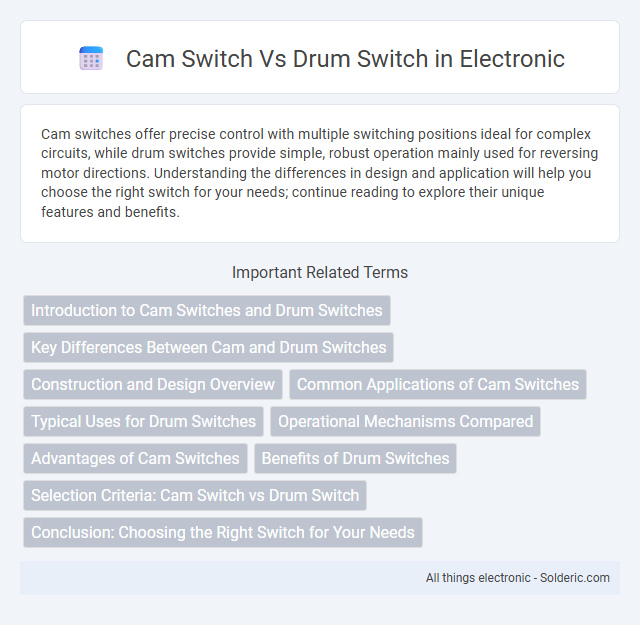Cam switches offer precise control with multiple switching positions ideal for complex circuits, while drum switches provide simple, robust operation mainly used for reversing motor directions. Understanding the differences in design and application will help you choose the right switch for your needs; continue reading to explore their unique features and benefits.
Comparison Table
| Feature | Cam Switch | Drum Switch |
|---|---|---|
| Function | Multi-position electrical switching | Reversing and controlling motor direction |
| Design | Rotary cam mechanism with multiple contacts | Rotary drum with winding contacts |
| Applications | Control panels, machines with multiple circuits | Motor control, reversing starter circuits |
| Contact Types | Multi-pole, multi-position | Typically two or three positions for direction control |
| Operation | Manual rotary action | Manual rotary action with switch-back feature |
| Typical Voltage Rating | Up to 600V AC/DC | Up to 600V AC/DC |
| Advantages | Versatile switching, compact | Robust, ideal for motor reversal |
| Limitations | Less suitable for heavy motor loads | Limited switching positions |
Introduction to Cam Switches and Drum Switches
Cam switches feature a rotating cam mechanism that precisely controls electrical contacts, enabling reliable multi-position switching often used in industrial control panels. Drum switches consist of a cylindrical drum with a wired cam track that sequentially makes or breaks contacts to control motor functions such as forward, reverse, and stop. Both switch types offer robust solutions for managing complex electrical circuits but differ in design and operation suited for specific applications.
Key Differences Between Cam and Drum Switches
Cam switches operate through a rotating cam mechanism that changes the electrical circuit position with precise, incremental movements, offering reliable control in low to medium voltage applications. Drum switches use a cylindrical drum with multiple contact patterns, enabling more complex switching sequences and typically supporting higher current and industrial motor control tasks. Key differences include the cam switch's simpler design for straightforward switching needs versus the drum switch's capability to handle multi-pole switching and reversing functions in heavy-duty environments.
Construction and Design Overview
Cam switches feature a rotating cam mechanism that makes or breaks electrical contacts with precise angular movement, ensuring reliable switching action in compact assemblies. Drum switches consist of a cylindrical drum with conductive segments and wiper contacts, providing multi-position control ideal for reversing motors and controlling complex circuits. Your choice between the two depends on the specific application requirements, such as durability, contact configuration, and ease of operation.
Common Applications of Cam Switches
Cam switches are widely used in industrial machinery for controlling motor functions, such as reversing, speed selection, and power distribution, due to their reliable mechanical operation and precise switching positions. You will often find cam switches in manufacturing equipment, conveyor systems, and control panels where robust and clear switching actions are required. Their ability to handle multiple poles and positions makes cam switches ideal for complex electrical control tasks in automated and manual processes.
Typical Uses for Drum Switches
Drum switches are commonly used for controlling large electric motors in industrial applications such as hoists, cranes, and conveyor belts where reversing the motor direction is necessary. These switches provide easy manual control over motor function, including start, stop, and reversing operations. Unlike cam switches, drum switches are specifically designed to handle high current loads and frequent motor direction changes safely.
Operational Mechanisms Compared
Cam switches operate using a rotating cam that systematically opens and closes electrical contacts to control circuits, providing precise switching actions and multiple positions. Drum switches utilize a cylindrical drum with conductive segments that rotate to establish contact paths, enabling smooth sequential switching typically for reversing motors or multi-speed settings. Both mechanisms ensure reliable circuit control, but cam switches offer more intricate contact arrangements, while drum switches emphasize durability and ease of maintenance in industrial applications.
Advantages of Cam Switches
Cam switches offer precise and reliable control over electrical circuits, making them ideal for complex machinery requiring multiple positions and functions. Their robust design ensures long-lasting durability and low maintenance, enhancing operational efficiency in industrial environments. You benefit from their compact size and ease of installation, which save valuable space and reduce setup time compared to drum switches.
Benefits of Drum Switches
Drum switches offer enhanced durability and reliability in industrial applications due to their robust construction and efficient rotary mechanism. They provide smooth, precise control over motor direction and speed, making them ideal for heavy-duty machines and reversing operations. Their compact design and ease of maintenance reduce downtime and operational costs compared to cam switches.
Selection Criteria: Cam Switch vs Drum Switch
Choosing between a cam switch and a drum switch depends on factors such as the complexity of control, switching capacity, and operational environment. Cam switches are ideal for applications requiring simple ON/OFF or multi-positional control with higher precision and longer mechanical life. You should opt for a drum switch when frequent switching with heavy loads is needed, especially in industrial machinery, due to its robust design and ease of maintenance.
Conclusion: Choosing the Right Switch for Your Needs
Choosing the right switch depends on your specific application requirements and operational needs. A cam switch offers precise control for complex multi-position functions, making it ideal for industrial machinery and automation systems. Your decision should consider factors such as load handling, switching frequency, and ease of maintenance to ensure optimal performance and longevity.
cam switch vs drum switch Infographic

 solderic.com
solderic.com